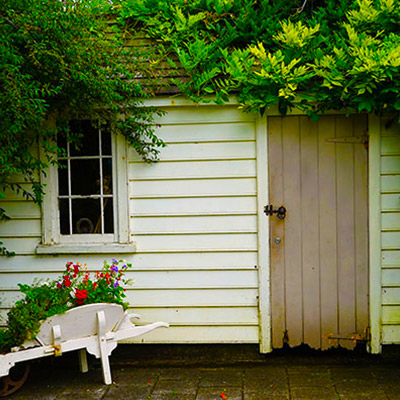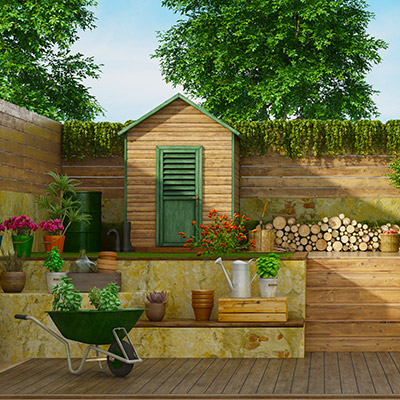Have you ever gone into your shed in the summer and felt stifled because of the scorching heat? Perhaps you’ve seen icicles forming on the rafters during the winter months. Thankfully, there is a way to eliminate these problems for good, so you can comfortably use your shed/outbuilding all year round. All you need is to have high-quality shed insulation installed.
If you are planning to use your shed regularly, then investing in shed wall insulation is essential. Insulating this area helps keep the interior temperature constant and unaffected by any extreme weather conditions outside.
Of course, you wouldn’t typically be considering this sort of project if you only intended to use your shed as storage space for your garden tools. Nowadays, though, an increasing number of people are opting to turn sheds into unique, useable areas that are separate from their main properties.
It therefore makes a lot of sense to have an insulation system installed in your shed, especially if you’re going to spend time in there quite often. From man caves to home offices and garden bars, insulation is sure to make your shed a cosier, more enjoyable place to be.

First, it’s essential to understand that heat always gravitates towards colder areas in an attempt to make the temperature more consistent. That’s why sheds easily heat up from the outside during summer and turn frigid from the cold in winter. There are three concepts that are in play here, namely:
• Conduction
This refers to how heat moves through solid objects. Through conduction, your shed will either gain or lose heat through its ceiling or walls. The walls, together with studs, create a continuous transfer of heat, both in and out.
• Convection
Heat moves through the air around us in a process called convection. Heat will move in and out of the shed through ceilings and walls this way, and any cracks or holes in the structure will tend to speed up this process.
• Radiation
Heat waves can transfer from one object to another – this process is referred to as radiation. This happens every day, from the sun shining through your window to the warmth of a fire making its way across the room. You can feel it when you sit on a rock that has been warmed by the sun. When you sit on a cold chair, your body warms it up, and it will stay that way until its temperature has equalised with the temperature of the air around it.
You’ll no doubt be aware of the difference between the temperature outside and the temperature in your shed. Usually, freezing temperatures outside will affect the environment in your interiors much faster than hot, summer temperatures. Either way, if you feel uncomfortable extremes of heat or cold in your garden shed, you’ll want to have more insulation installed in your walls and ceiling.
It’s entirely possible that some form of insulation is already installed in your shed. Your first decision should be whether you want to leave the existing system in place and simply add an additional layer of insulation, or have it removed entirely and start again from scratch. Once you add spray foam insulation to the shed, the fresh layer provides additional U-value.
The U-Value is a term that is common in the construction and renovation industries. Essentially, it’s an indicator of how good a material is at preventing conducive airflow or heat/thermal transmittance.
Working out the U-Value of a given area is relatively simple – you need to take into consideration the thermal resistance of each material making up the building application in question. The thermal resistance is the thickness of a building element ÷ conductivity (k-value) – this is the R-Value. In order to find the overall U-value, you must add the R-Value of each element together and divide this number by 1, and this will equal the U-Value.
The recommended U-Value of the materials that you should use depends on the climate that you live in. You can also refer to local building regulations or ask your local buildings inspector about the minimum values that are needed for your location.
There are different shed insulation options to choose from on the market, and they all differ in terms of form and composition. Here, we’re going to focus on spray foam, which is one of the latest insulation solutions on the market today.

• Roofs - Flat & Pitched
• Cavity Walls
• Underfloor on a suspended timber floor
• Warehouse – Roof/Walls
• Many more...
Spray foam insulation is excellent for concrete and frame walls, and can also be applied to tight, odd-shaped spaces. Spray foam can be used in the following areas:
• Roofs - Flat & Pitched
• Cavity Walls
• Underfloor on a suspended timber floor
• Warehouse – Roof/Walls
• Many more...
Spray foam is arguably the best insulation for sheds that you can use because it has one of the highest insulating factor per inch of all insulation materials.

If you’re looking to invest in insulation, get in touch with Eco Spray Foam today. We are an Icynene-accredited quality insulation provider that offers bespoke insulation services across the entire United Kingdom.
For over two decades, Eco Spray Foam has been delivering premium quality products and expert services across the whole of the UK. We have the latest technological insulation solutions for modern-day applications and are certified users of the Icynene spray foam product, which is one of the newest insulating technologies on the market today.
To find out more about shed insulation in the UK or to get a free insulation survey for your residential or commercial property, get in touch with us by ringing 0203 411 5188 or by using our online contact form at https://www.sprayfoam.co.uk/contact.html.
Our friendly team of experts here at Eco Spray Foam are ready to provide advice and guidance on the best insulation solutions for your home and garden buildings.
It is useful to know that not all sheds can be insulated. However, insulation can be installed in the majority of garden sheds.
To start, you’ll need to thoroughly inspect your shed to make sure that it’s dry and waterproof. If any portion of your shed is leaking before you install insulation, then you can expect mould and decay to occur, which defeats the point of insulating it in the first place.

Without a doubt, insulated sheds have more value than a regular, uninsulated space. Some additional purposes that insulation facilitates include:
Storage for temperature-sensitive items
Home office
Additional guest room
Arts or craft studio
Summer house
Housing for your pets or livestock
If you’re looking to use your shed all year round, you’ll probably want to consider having spray foam shed insulation installed to ensure a warm and comfortable workspace. An ordinary garden shed is often made entirely from timber and a felt roof, which doesn’t offer much protection from the cold, damp or draughts. The process of installing rafter thermal protection isn’t as daunting as you may think and is relatively affordable too.
Choosing from the various shed insulation options available to you will generally boil down to your own unique needs and the budget you have to spend on the project.
The main things to consider include:
The type of insulation:
It can be spray foam (which is one of the most effective forms of garden house defense at present) wool, insulation boards, aluminium foil-backed bubble wrap, and more.
The size of your shed & coverage area:
Knowing this will help you choose the right size of insulation.
Ease of installation:
This is dependent on the type of insulation used. Most insulation types are easy to install, as long as you have a few hours to spare. Spray foam, in particular, is very easy to install since it can simply be sprayed into gaps.
The importance of concrete garage insulation cannot be stressed enough, especially in the lining-out process. By insulating the property, you are helping keep valuable heat inside while reducing the possibility of condensation forming at the same time. There are different options to choose from for your concrete garage insulation project.
We understand that any insulation project, whether it be garage or woodshed insulation, requires in-depth consideration before you spend your hard-earned money. For your convenience, our experts are always willing to recommend the right solution for you. Contact us for a free property survey today!